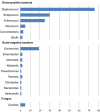Bacterascites: A study of clinical features, microbiological findings, and clinical significance
- PMID: 29992711
- PMCID: PMC6282964
- DOI: 10.1111/liv.13929
Bacterascites: A study of clinical features, microbiological findings, and clinical significance
Abstract
Background: Knowledge about bacterascites is limited and management guidelines are based on small patient series. The purpose of this study was to add further insight into the clinical characteristics, microbiological findings, and prognosis of patients diagnosed with bacterascites.
Methods: Retrospective analysis of patients with advanced chronic liver disease diagnosed with bacterascites and SBP between January 2003 and August 2016.
Results: In this study, 123 patients were included with 142 episodes of bacterascites. The median MELD score was 20 and clinical symptoms of infection were present in 78%. Empiric antibiotic treatment was initiated in 68%. In 26 untreated patients undergoing repeated paracentesis, 42% were diagnosed with either ongoing bacterascites or SBP. The presence of signs or symptoms of infection was not an independent predictor for mortality or spontaneous resolution of infection. The 1-month and 1-year mortality rates of the 123 patients studied, were 32% and 60%, respectively; these results were in line with data pertaining to the prognosis of SBP.
Conclusions: Patients with bacterascites and SBP are highly comparable with respect to severity of liver disease and overall prognosis. If left untreated, bacterascites is likely to persist or to evolve to SBP in a significant proportion of patients. The results of this study support current guidelines regarding the treatment of ascitic fluid infection, but could not confirm the prognostic relevance of symptomatic disease at the time of diagnosis. We suggest that the threshold to initiate antibiotic treatment, in particular in cases with severely advanced liver disease, should be low.
Keywords: bacterascites; cirrhosis; microbiology; spontaneous bacterial peritonitis.
© 2018 The Authors Liver International Published by John Wiley & Sons Ltd.
Figures




Comment in
-
How to reduce mortality of bacterascites-That is the question.Liver Int. 2018 Dec;38(12):2129-2131. doi: 10.1111/liv.13976. Liver Int. 2018. PMID: 30480379 No abstract available.
References
-
- Rimola A, Garcia‐Tsao G, Navasa M, et al. Diagnosis, treatment and prophylaxis of spontaneous bacterial peritonitis: a consensus document. International Ascites Club. J Hepatol. 2000;32(1):142‐153. - PubMed
-
- Pinzello G, Simonetti RG, Craxi A, Di Piazza S, Spano C, Pagliaro L. Spontaneous bacterial peritonitis: a prospective investigation in predominantly nonalcoholic cirrhotic patients. Hepatology. 1983;3(4):545‐549. - PubMed
-
- Runyon BA, Hoefs JC, Canawati HN. Polymicrobial bacterascites. A unique entity in the spectrum of infected ascitic fluid. Arch Intern Med. 1986;146(11):2173‐2175. - PubMed
-
- Runyon BA. Monomicrobial nonneutrocytic bacterascites: a variant of spontaneous bacterial peritonitis. Hepatology. 1990;12(4 Pt 1):710‐715. - PubMed
-
- Pelletier G, Lesur G, Ink O, et al. Asymptomatic bacterascites: is it spontaneous bacterial peritonitis? Hepatology. 1991;14(1):112‐115. - PubMed
Publication types
MeSH terms
Substances
LinkOut - more resources
Full Text Sources
Other Literature Sources
Medical

